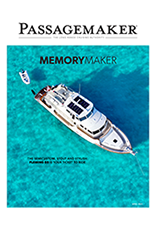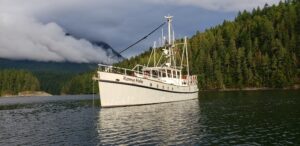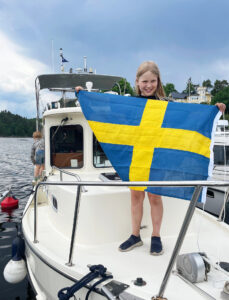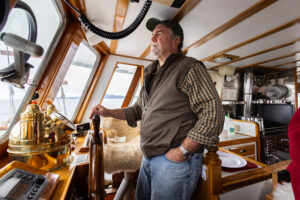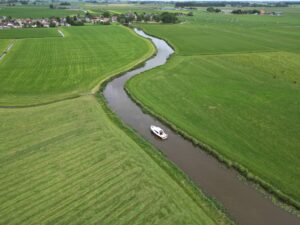
As the first gray light filtered through the cabin windows, I could hear the steady patter of raindrops on the cabin roof. It was a sound that would have ruined a vacation anywhere else in the world, particularly on a bareboat charter like ours, but I was unconcerned. In fact, I was pleased, because we were cruising in the San Juan Islands of the Pacific Northwest.
The one piece of advice that we had received from everyone, fishermen to dockmasters, was that if it drizzled in the morning, it would produce a fine afternoon. So I snuggled back into the warm covers and dozed off for another hour.
Over the years, we’ve chartered a number of boats around the world, but the problems of political unrest and the high cost of airfare to get anywhere had discouraged us. What we really wanted was a cruise that would take us away from civilization, where we could lean back in the cockpit and enjoy a beer and a good book without interruption. One where the kids could hike and row without my wife and I having to constantly worry about them. And then we saw the advertisement.
It was innocuous enough—a charter company touting the delights of cruising in the Pacific Northwest, but it got us hooked. Soon, brochures were filling our mailbox and we narrowed our choices to a company based in Anacortes, just a short hop away from the San Juan Islands, because we didn’t want to waste time getting from Seattle to our cruising area.
While mid-summer in the San Juans can be a floating madhouse with packed marinas and crowded harbors, the shoulder seasons on the edge before and after the summer vacation can be delightful, and that is what we chose.
There were some other side benefits to a bareboat charter in the San Juans besides reasonable airfares. First, of course, is the language, and even those of us from the deepest South had no problem communicating with the natives. The money is the same, so there are no foreign exchange issues. Credit cards work just fine, and you can provision at stores with names you know. Cell phones work too, although that may not be the good news.
TRY IT OUT FIRST
There’s another interesting side to chartering in the Northwest: the eclectic variety of boats available. Unlike the Caribbean, where charter companies fill their docks with look-alike boats, charter companies in the Pacific Northwest manage privately-owned yachts, so the fleets include everything from nearly-new yachts to well-maintained classics. The variety of offerings is amazing.
This means that you can use a Northwest charter to try out almost any type of yacht that interests you, because there is probably one in a charter fleet. A sea trial on a boat tells you a bit, but living aboard with your family and friends for a week will tell you everything you need to know before you buy. From the hundreds of offerings, we chose a 43-foot trawler that was small enough for a couple to handle easily, but large enough for two couples with kids during a week of cruising.
ABOUT THE SAN JUANS
The San Juan Islands are a democratic archipelago: there’s literally something for everyone. Without going more than a half-day in any direction at a leisurely pace, you can find hundreds of small coves, wildlife to watch, fossils to hunt, small villages, resorts to enjoy, beaches set in pine forests, and protected waters suitable for boats of all sizes. Local residents claim there are 750 islands at low tide but only 450 at high tide, but that’s really an unresolved question. At least 150 islands have names, so you may want to make your own estimates.
The San Juans lie roughly 60nm north of Seattle, forming an oval. San Juan Island is on the west with its back facing Canada’s Vancouver Island and Orcas Island drapes limply across the top of the cluster, while the remaining islands lie between San Juan Island and Orcas Island, and the mainland to the east. Carved into their present shape by the great glaciers of the Ice Age, the terrain bears the scars of the ponderous ice: deep slashes, smoothly planed rocks, and piles of rocky litter. The summer offers the best weather with warm days and sunny skies, but the “shoulder” seasons of spring and fall are still pleasant and less crowded.
The first day of our vacation was a long one. We flew to Seattle, rented a car, and drove to Anacortes, realizing for the first time what a wise decision it was to charter close to our destination. Our trawler was waiting for us, shiny and tidy, and a short check-out introduced us to the systems aboard and proved that we wouldn’t have any trouble handling the craft. We’d planned our meals before leaving home, and our rental car carried us to a nearby grocery store for a weeks worth of food. Stowage and final details took longer than we expected, and docklines were finally cast off in late afternoon.
A word about charter times: a one-week charter like ours will last, for example, from Sunday afternoon to the following Saturday morning when the boat must be returned before noon to prepare for the next charter. Don’t plan to go too far on your first day, since the check-out and gear storage will always take longer than you expect.
INTO THE ISLANDS
Once clear of Anacortes, we planned to spend the night at nearby James Island, a 100-acre marine park with twin coves, moorings, and some facilities ashore. We made a good choice because it had been a tiring day and we were ready for an early evening. We lucked into a mooring ($10 a night) and moments later sat down to steaming bowls of chowder at the dinette as darkness descended outside. The only sounds were the occasional splash of a fish or the faint breeze rustling in the trees. It was exactly what we had hoped for, and as far as we were concerned, the world was already a million miles away.
Day two introduced us to the morning drizzle that we’d been expecting, and we spent a couple of hours re-stowing food and gear that had been loaded in haste. The clouds broke by mid-morning as predicted and we took the dinghy ashore to explore.
There are a dozen Washington State Marine Parks in the San Juan Islands, with most of them accessible only by boat. Each is in almost undisturbed condition, with a few picnic facilities, piers for landing, and trails to build your muscles and appetites. The towering green canopy of leaves overhead was a delightful change from the burning skies of so many charter areas.
It turned into a magnificent afternoon, with fluffy cumulus drifting overhead, a steady wind, warm sun, and we were soon cruising westward. Stretched out on the flybridge, we watched farms and homes slide past, many with grassy meadows sweeping to the water’s edge, surrounded by towering pines. We took turns imagining where we were in the world, with the best choices being somewhere on the coast of Maine (not enough lobster pots), on a lake in Switzerland (not enough peaks), or exploring the Scandinavian archipelago (too warm).
HANGING OUT IN FRIDAY HARBOR
We decided to re-enter civilization (and pick up a few forgotten supplies) by spending the night in Friday Harbor, and we picked up a transient slip at the city marina. If you make a reservation (on VHF channel 66A and at 360.378.2688) there is a $6 reservation surcharge in addition to the per foot rate of $1.55 up to 43 feet. Anything 44 feet or more is a flat $1.75 per foot for reservations, with no surcharge. Friday Harbor has a no-turn-away policy and will fit you in somewhere on a first-come, first-serve basis.
A short walk took us to the main street and, except for the automobiles, we might have passed through a time warp into a 19th-century fishing village. A few salty characters were striding along in knee boots and canvas jackets, the buildings were clapboard and elderly, and even the shade trees overhanging the small park were out of an old painting. The afternoon passed quickly as we explored the small shops where the proprietors were delighted to lean on the counter and chat. Our cooks staged a minor rebellion in favor of a restaurant overlooking the harbor and just as we were leaving, the last ferry arrived, and we sat on a park bench watching the cars drive past, feeling like locals.
Leaving Friday Harbor the next day, we dawdled along the wooded shores with the bulk of Vancouver Island in the haze to the west, but our destination was Roche Harbor, a protected cove on San Juan Island. Once a limestone quarry, only the Victorian buildings remain to indicate a grand past, and we soon had tucked into an empty slip. The facilities are excellent, with a laundry room and hot showers for visiting yachts. At sunset, the flag lowering ceremony was followed by a weather forecast over the dock loudspeaker, complete with the chill temperatures in less fortunate cities around the world, which brought laughter to the docks. As night fell, the lights of the hotel went on, turning the gardens and walkways into a miniature Tivoli Gardens of the Pacific Northwest.
THE OTHER ISLANDS
We lingered over pancakes and sausage the next morning before setting out for Stuart Island. En route, we circled Spieden Island, which has short grass in place of the common tall timber. In the 1970s, the island was transformed into a hunting preserve and stocked with lions and tigers for the pleasure of big-game hunters unable to afford the real African veldt, and apocryphal stories are told about the ghosts of the animals still prowling and howling on moonless nights.
Stuart Island has a strip-like marine park connecting the two fine anchorages of Reid and Prevost Harbors. We chose Reid, where we picked up a mooring and explored a winding path through the park. Unlike the previous days, however, the edges of the clouds were starting to turn dark and we just reached the pier as the first big drops splattered down.
We were warm and comfortable inside our boat, with the coals in the cabin stove glowing pleasantly, hot chocolate on the stove, and rain drumming outside. Unfortunately, we chose to introduce the youngsters to the card game called Hearts, at which they promptly beat us mercilessly.
The morning dawned bright and clear, and we sailed to our last overnight anchorage at Sucia Island—one of the most popular of the San Juans, it’s actually a cluster of 11 islands with several distinct anchorages. We chose to anchor at Fossil Bay (perhaps the most protected of Sucia Island anchorages) in good holding near the landing float. In the summer, hundreds crowd this harbor during the summer season. but it remains quiet because generators are prohibited at night. Since Sucia is close to the mainland, there were even a few small outboard boats pulled up at the float, with their crews pitching brightly colored tents in the grassy campground.
The smell of their campfires moved our dinner plans forward rapidly and afterward, we rowed ashore to join the other families watching the sunset over Little Fox Cove. All the colors of the rainbow, from purple to rose, radiated over the yachts bobbing quietly at anchor. It was the perfect end to our cruise.
It had been one of the best charters we have ever had—clean air, beautiful scenery, delightful people, pleasant weather, and no problems at all if we overlooked being beaten at Hearts. Best of all, when we tallied up the cost of the charter, food, and other expenses, we found that it had been the least expensive vacation we’d ever had. Next year, we’ll be back to explore more of the San Juans.
We’ll also see how good the kids are at Canasta.
